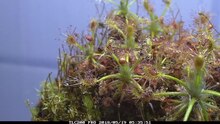Drosera enodes
| Drosera enodes | ||||||||||||
|---|---|---|---|---|---|---|---|---|---|---|---|---|

Drosera enodes , Habitus (in culture) |
||||||||||||
| Systematics | ||||||||||||
|
||||||||||||
| Scientific name | ||||||||||||
| Drosera enodes | ||||||||||||
| NGMarchant & Lowrie |
Drosera enodes is a carnivorous plant from the genus sundew ( Drosera ). It belongs to the group of so-called dwarf sundews and is native to southwestern Australia.
description
Drosera enodes is a perennial herbaceous plant . This forms a compact rosette-shaped bud of horizontal and semi-upright leaves rosette with a diameter of about 2.5 cm and 1.5 cm in height. The stem axis is 1.55 cm long and covered with withered leaves from the preseason.
The bud of the stipules is ovate, shaggy, 7 mm long and 5 mm in diameter at the base. The stipules themselves are 3 mm long, 2 mm wide and three-lobed. The middle lobe is divided into 3 segments.
The leaf blades are elliptical, up to 2 mm long and 1.5 mm wide. The longer tentacle glands are on the edge, the shorter ones on the inside. They are hairless on the underside. The leaf stalks are up to 8 mm long, 0.8 mm wide at the base and taper to 0.5 mm at the leaf blade. They are covered on the underside with only a few, small glandular hairs.
Flowering time is September to November. The one to three flower stems are up to 7.5 cm long and completely hairless. The inflorescence is a coil of 3 to 20 flowers on approximately 4.5 mm long pedicels. The narrow, egg-shaped sepals are 2 mm long and 0.9 mm wide. The edges are irregularly serrated and the surface hairless. The white petals are narrowly elliptical with a small finger-like section at the base, 3.5 mm long and 1.2 mm wide.
The five stamens are 1.5 mm long. The threads are white, the anthers and pollen are yellow. The greenish-white ovary is shell-shaped, 0.6 mm long and 0.6 mm in diameter. The 3 white, upright styluses are 0.5 mm long and 0.1 mm in diameter. The scars are white, curved inward, 1.5 mm long and 0.2 mm in diameter at the base.
The formation of brood scales is typical for dwarf sundews.The egg-shaped, 1 mm thick brood scales are formed in large numbers from late November to early December and are approx. 2 mm long and 1.2 mm wide.
Distribution, habitat and status
Drosera enodes only occurs in a small area in the extreme southwest of Australia. The plant thrives there on the edges of swamps in black, peaty sand in the Scott River Region and on clay and laterite soils in winter-damp water pools protected by jarra trees in the Busselton area .
Drosera enodes is not uncommon, threatened or introduced in Western Australia
Systematics
The name "enodes" (= without knots) refers to the short stems of this species. Drosera enodes was described as a species in 1992 by Allen Lowrie and Neville Graeme Marchant .
literature
- Allen Lowrie : Carnivorous Plants of Australia. Volume 2. University of Western Australia Press, Nedlands 1989, ISBN 0-85564-300-5 , p. 54.

